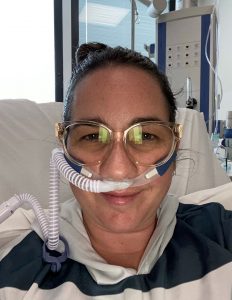
“There was no airflow into my left lung.”
Like many people with asthma, Stephanie Lanteri has had it since childhood and it always flare-ups during winter and spring.
As a mother to three children – at age 35 she moved to a new house in country Victoria. It should have been the fresh air Steph and her family were looking for.
“We moved into our new estate. It was still in development, so we were surrounded by constant earthmoving works, building sites and dust. It started to bring my asthma on, so I needed my Ventolin more.”
Steph is located a few hours’ drive from Bendigo, which is the closest town with a major hospital. She sees her usual doctor for her asthma and was taking preventer medication each day.
Steph was unaware that needing her blue/grey reliever puffer more than twice a week is a serious sign that needs attention.
“This one morning, I broke out in a rash all over my body, my nose swelled three times bigger than usual, and I couldn’t breathe. I spent four hours in our local hospital emergency being treated for asthma. The thing was that my asthma didn’t wheeze.”
When you have an asthma attack and you can’t hear a wheeze, it can be a sign that not enough air is entering the lungs, known as a severe asthma attack.
Steph’s airways were extremely sensitive and inflamed, making her asthma volatile and at risk of another attack. At the local asthma clinic they spoke to Steph about asthma first aid, asthma action plans, and how to use a spacer.
“My doctor changed my preventer and we decided I would return in a couple of weeks to make an asthma plan and see how I felt after changing preventers. I’ve never had an asthma plan all this time.”
However, Steph’s asthma didn’t wait for the new preventer to kick in. She was about to experience several asthma attacks that would see her husband ‘preparing for the worse’.
“The next week, I woke up short of breath. I tried the asthma first aid technique with the spacer just how I was told at the asthma clinic. I knew it was bad but to be honest, I was avoiding hospital because of the COVID-19 protocols.”
With no signs of improvement, Steph’s husband took her to hospital for treatment.
“After much back and forth with the COVID-19 protocols, a doctor finally listened to my chest but he said he couldn’t hear any wheezing. The doctor on duty thought I was having a panic attack and gave me some medication to calm me down. They wanted me to rest and left me there in a room where I cried the entire time whilst struggling to breathe. I was really scared at this point.”
“Over that period the nurses changed shifts. The new nurse took one look at me and put me on oxygen. I swear she saved my life.”
“The doctor who treated me the previous week and knew about my asthma arrived and advised the other doctor on shift that I was having an asthma attack.”
“Eventually they put me on FaceTime with Ambulance Victoria. She took one look at me and said she was sending a helicopter to take me to ICU at Bendigo Hospital.
“I didn’t know at the time, but they had told my husband to prepare for the worst.”

“There was no airflow into my left lung at all.”
At Bendigo Hospital, the team were able to provide Steph with the immediate care she needed in ICU. Her family were able to make it to the hospital where she spent the next four days.
“Before I left, I was given my first ever asthma plan, my preventer was changed again, and I now have emergency medication at home as sometimes it can take three weeks to get in to see a doctor here.”
Steph wants other people with asthma to be aware of the warning signs of poor asthma control.
“I have asked my doctor in the past about my asthma medication but what was always overlooked was the amount of Ventolin I would use. I didn’t know that using it more than twice a week meant my asthma wasn’t well controlled – so I never mentioned it and my doctor never questioned it.”
“The pharmacist always gave me the prescription without asking any questions too. These are really important opportunities for people to be asked about their asthma control that are being missed for most people.”
Not sure what to ask or tell your doctor about your asthma? We’ve developed a resource to help guide you through your next Asthma Review – the Asthma Review Worksheet. Download it for free and have a better doctor’s appointment.
Asthma Australia would like to thank Steph for her courage and for sharing her story. Thank you for being a voice for people with asthma.
Do you have a story to tell? Become an Asthma Champion.






